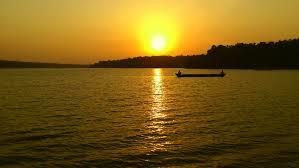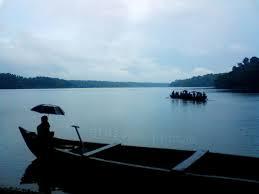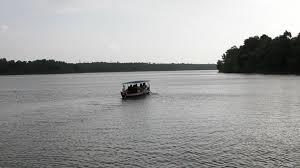Sasthamcotta Lake – Queen of Lakes in Kerala
Sasthamcotta Lake is the largest freshwater lake in Kerala. Due to its sheer size, it is also categorized as a wetland. This lake is situated very close to the West Coast in the Kollam district of Kerala. The water from this lake is used for providing drinking water for half a million people in that district. Being a freshwater lake, it has a lot of fishing resources. The locals do not have to venture into the sea for getting the fish. This lake is designated as the wetland under the Ramsar Convention.
Sasthamkotta Lake
This lake is also known by the name Sasthamkotta Lake. It is considered as the wetland of global stature under the Ramsar Convention since the year 2002. The lake derives its name from an ancient Sastha temple located on its bank. This is considered as the largest freshwater lake in the southern state of Kerala. The aquatic biologists in this state attribute the purity of water in this lake to the presence of a larva called cavaborous. They say that the large population of cavaborous larvae feeds on bacteria present in this lake and make water clean on a continuous basis. This lake is located at a distance of 25 kilometres from Kollam city. Hence, it is present on the northern side of Ashtamudi Lake. The lake water is also reported to be free of sodium chloride and other minerals. This is what the report compiled by World Wildlife Fund has indicated last year. The report seemed to have given a clean chit to the quality of water present in this lake. All the available indicators conform to the world standards of drinking water prescribed by various regulatory bodies across the world.
Geography
The largest freshwater lake is separated from the paddy fields on its southern side by an earthen embankment. This 1.5-kilometre long embankment borders the alluvial plains watered by the Kallada River. The other three sides of the lake are surrounded by hills that are steep. Hence, the lake on the northern side enters into narrow valleys near this hill formations. Along with the embankment, there are small water bodies and waterlogged areas on the southern side of the lake. The total area of the lake is at present admeasures to 375 hectares. In the past, the lake used to much bigger than what it is now. It is mainly due to the taking of large areas of the lake for agriculture purpose over a period of time. The closest town from the lake is Karunagapally. This town is just 8 kilometres away from the largest freshwater lake. There is a ferry service across this lake that transports people between West Kallada and Sasthamkotta regions.
Water Source for Lake
No tributary of any river seems to feed water into this water body. The geologists say the lake stay fed with water emanating from the underwater springs throughout the year. The volume of water stored in this freshwater lake stands at 22.4 million cum. The lake is also rain-fed. However, a thick mantle of soil rich in mineral Kaolinite surrounding the lake checks the flow of water into the lake. The catchment area of the lake receives 2398 millimetres of rain during monsoon season. Due to this reason, the ground water table in this area stands at 3.89 metres. Flora
According to the biologists of the state, the insectivorous plant Drosera is found on the eastern shore of the lake. Other forms of vegetation are negligible near the lake. At the lake, you can find floating and rooted plants. However, there number is grossly insignificant to cause sizeable impact to the water ecosystem. On the banks of the lake, visitors can see paddy, tapioca, cashew nut and plantain cultivated. It is believed these crops grow abundantly in this picturesque environment due to the presence of abundant water and fertile soil. 
Aquatic and Land-based Fauna
When we come to the fauna present in the region, we should not skip mentioning about 27 species of fishes available. They include pearl spot and catfish. Apart from them, one can catch 2 genera of prawns and 21 species of sardines and herrings. People go out to meet the migratory birds early in the morning and listen to their sounds. The bird watchers come to meet the smallest migratory bird Common Teat. It is locally called as dabbling duck. The visitors can also see some of the endangered species in the vicinity of the lake. They are Puntius ticto, Parambassis thomassi and Horabagrus brachysoma. On the land, you can see troupes of monkeys that live in the nearby Sastha temple on the banks of the lake. The visitors can also watch 9 types of butterflies, 13 species of insects, 2 Hymenopterans and 2 Odonates near the lake.Attractions Near the Lake
The banks of lake provide some of the best views of nature. Travelling by ferry or boat gives some of the best views of the rustic lives in that part of the world. A temple on the banks of the lake offers another dimension to the experience. We are trying to list out some of the attractions that make people visit this place again and again.
Conclusion
Sasthamkotta is the largest freshwater lake in the southern state of Kerala. The purity of water is such that it can be utilized as potable water without boiling. It has a small embankment on its southern side that borders the alluvial plains watered by the Kallada River. Near the embankment, one can see small water bodies and waterlogged areas that to some extent provide water for irrigation. There is Sastha temple on the bank of the lake. The presiding deities of this ancient temple are Lord Ganesha and Lord Ayyappa. A group of monkeys lives in the premises of this temple that add to the serene atmosphere of the temple. Visitors to this place can avail the cruise and ferry services to imbibe the beauty of the nature around the lake. They can even avail the houseboat service to enjoy the stay near the lake.

 Job oriented
Job oriented